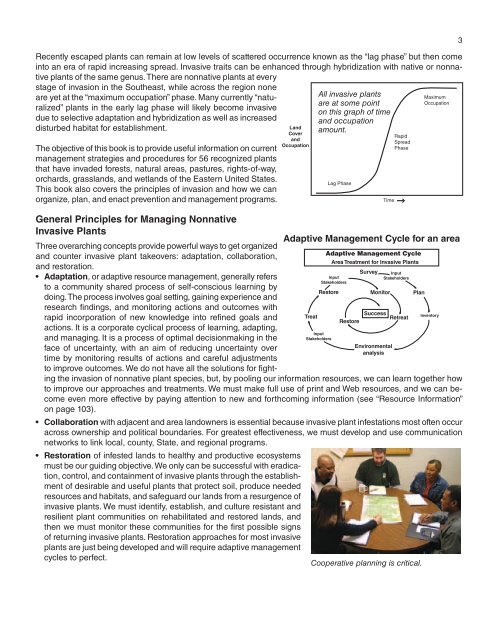A Management Guide for Invasive Plants in Southern Forests James ...
A Management Guide for Invasive Plants in Southern Forests James ...
A Management Guide for Invasive Plants in Southern Forests James ...
- No tags were found...
You also want an ePaper? Increase the reach of your titles
YUMPU automatically turns print PDFs into web optimized ePapers that Google loves.
Recently escaped plants can rema<strong>in</strong> at low levels of scattered occurrence known as the “lag phase” but then come<strong>in</strong>to an era of rapid <strong>in</strong>creas<strong>in</strong>g spread. <strong>Invasive</strong> traits can be enhanced through hybridization with native or nonnativeplants of the same genus. There are nonnative plants at everystage of <strong>in</strong>vasion <strong>in</strong> the Southeast, while across the region noneare yet at the “maximum occupation” phase. Many currently “naturalized”plants <strong>in</strong> the early lag phase will likely become <strong>in</strong>vasivedue to selective adaptation and hybridization as well as <strong>in</strong>creaseddisturbed habitat <strong>for</strong> establishment.The objective of this book is to provide useful <strong>in</strong><strong>for</strong>mation on currentmanagement strategies and procedures <strong>for</strong> 56 recognized plantsthat have <strong>in</strong>vaded <strong>for</strong>ests, natural areas, pastures, rights-of-way,orchards, grasslands, and wetlands of the Eastern United States.This book also covers the pr<strong>in</strong>ciples of <strong>in</strong>vasion and how we canorganize, plan, and enact prevention and management programs.General Pr<strong>in</strong>ciples <strong>for</strong> Manag<strong>in</strong>g Nonnative<strong>Invasive</strong> <strong>Plants</strong>LandCoverandOccupationAll <strong>in</strong>vasive plantsare at some po<strong>in</strong>ton this graph of timeand occupationamount.RapidSpreadPhaseLag PhaseTimeMaximumOccupationAdaptive <strong>Management</strong> Cycle <strong>for</strong> an areaTreatAdaptive <strong>Management</strong> CycleArea Treatment <strong>for</strong> <strong>Invasive</strong> <strong>Plants</strong>Survey InputInputStakeholdersStakeholdersRestoreMonitor PlanInputStakeholdersSuccessRetreatRestoreEnvironmentalanalysisThree overarch<strong>in</strong>g concepts provide powerful ways to get organizedand counter <strong>in</strong>vasive plant takeovers: adaptation, collaboration,and restoration.• Adaptation, or adaptive resource management, generally refersto a community shared process of self-conscious learn<strong>in</strong>g bydo<strong>in</strong>g. The process <strong>in</strong>volves goal sett<strong>in</strong>g, ga<strong>in</strong><strong>in</strong>g experience andresearch f<strong>in</strong>d<strong>in</strong>gs, and monitor<strong>in</strong>g actions and outcomes withrapid <strong>in</strong>corporation of new knowledge <strong>in</strong>to ref<strong>in</strong>ed goals andactions. It is a corporate cyclical process of learn<strong>in</strong>g, adapt<strong>in</strong>g,and manag<strong>in</strong>g. It is a process of optimal decisionmak<strong>in</strong>g <strong>in</strong> theface of uncerta<strong>in</strong>ty, with an aim of reduc<strong>in</strong>g uncerta<strong>in</strong>ty overtime by monitor<strong>in</strong>g results of actions and careful adjustmentsto improve outcomes. We do not have all the solutions <strong>for</strong> fight<strong>in</strong>gthe <strong>in</strong>vasion of nonnative plant species, but, by pool<strong>in</strong>g our <strong>in</strong><strong>for</strong>mation resources, we can learn together howto improve our approaches and treatments. We must make full use of pr<strong>in</strong>t and Web resources, and we can becomeeven more effective by pay<strong>in</strong>g attention to new and <strong>for</strong>thcom<strong>in</strong>g <strong>in</strong><strong>for</strong>mation (see “Resource In<strong>for</strong>mation”on page 103).• Collaboration with adjacent and area landowners is essential because <strong>in</strong>vasive plant <strong>in</strong>festations most often occuracross ownership and political boundaries. For greatest effectiveness, we must develop and use communicationnetworks to l<strong>in</strong>k local, county, State, and regional programs.• Restoration of <strong>in</strong>fested lands to healthy and productive ecosystemsmust be our guid<strong>in</strong>g objective. We only can be successful with eradication,control, and conta<strong>in</strong>ment of <strong>in</strong>vasive plants through the establishmentof desirable and useful plants that protect soil, produce neededresources and habitats, and safeguard our lands from a resurgence of<strong>in</strong>vasive plants. We must identify, establish, and culture resistant andresilient plant communities on rehabilitated and restored lands, andthen we must monitor these communities <strong>for</strong> the first possible signsof return<strong>in</strong>g <strong>in</strong>vasive plants. Restoration approaches <strong>for</strong> most <strong>in</strong>vasiveplants are just be<strong>in</strong>g developed and will require adaptive managementcycles to perfect.Cooperative plann<strong>in</strong>g is critical.Inventory3
















